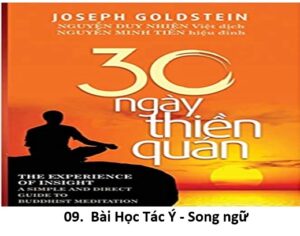Eight Morning – Bài Học Tác Ý – Instruction: Intentions – Song ngữ
English: Joseph Goldstein.
Việt ngữ: Nguyễn Duy Nhiên.
Compile: Lotus group.

Eight Morning – Bài Học Tác Ý – Instruction: Intentions

There is wide support for three dimensions or domain:
1) cognition (knowing, understanding, thinking);
2) affect (feelings, emotions, attitudes, predispositions); and
3) conation (volition, will, intentions to act, reasons for taking action).
Volition is a common factor of mind present in every moment of consciousness. When it is predominant, it should be noticed. Volition is the mental urge or signal which precedes any action. When we are mindful of volitions and intentions, we then have the freedom to choose whether or not we want to act on them. As long as we remain unaware of intentions, actions will follow automatically.
Ý muốn là một yếu tố thông thường, lúc nào cũng có mặt trong tâm ta. Khi nào nó khởi lên, ta phải ghi nhận nó. Ý muốn, hay còn gọi là tác ý, là một sự thúc dục trong tâm, một dấu hiệu đi trước bất cứ một hành động nào. Khi mà ta có chánh niệm nhận diện được ý muốn hay tác ý của mình, ta sẽ có sự tự do lựa chọn: hành động hay không hành động theo chúng. Còn nếu ta sống trong quên lãng không biết đến sự có mặt của tác ý, ta sẽ bị chúng sai xử một cách máy móc.
For example, when you are sitting in meditation, before you stand up, there is an intention to stand. When you notice the intention, which will arise and pass away, you will perhaps go on sitting, because you have been mindful of it, not identifying with it.
Thí dụ, khi bạn đang ngồi thiền, trước khi bạn đứng dậy, bao giờ cũng có một tác ý muốn đứng lên. Nếu bạn ghi nhận được tác ý này, nó sanh lên rồi diệt đi, có lẽ bạn vẫn còn tiếp tục ngồi thiền. Bởi vì bạn đã có chánh niệm, ý thức được nó, chứ không cho nó là mình.

A lot of insight into the cause-and-effect relationship
of mind and body develops through this kind of observation.
If the intention arises without mindfulness, we find ourselves standing, without having been aware at all of the process involved. It is that way with all voluntary movements of the body. So, when intentions are predominant, as they are between radical changes of posture, between sitting and standing, standing and walking, be mindful of them. In walking, there is an intention to stop before stopping. There is an intention to turn before turning. There is no need to single out the intention with each step, but it is helpful to notice it when you come to the end of your walk, just as you are beginning to turn. The foot by itself does not make that turning movement. It turns because of a preceding volition. A lot of insight into the cause-and-effect relationship of mind and body develops through this kind of observation.
Còn nếu tác ý khởi lên, nhưng vì thiếu chánh niệm, bạn sẽ thấy mình đứng lên mà chẳng nhớ vì sao. Mọi hành động khác của ta cũng vậy. Thế cho nên mỗi khi có một một tác ý nào khởi lên, như khi đổi oai nghi của thân thể giữa đi, đứng, nằm, ngồi, ta phải nhớ có chánh niệm về chúng. Trong khi đi, bao giờ ta cũng có tác ý muốn dừng lại trước khi thật sự dừng. Ta có tác ý đổi hướng trước khi quay người lại. Chúng ta không cần phải niệm tác ý của từng bước chân một, nhưng mỗi khi đi kinh hành đến cuối đoạn đường, ta nên ghi nhận tác ý muốn đổi hướng, trước khi bắt đầu quay người lại. Bàn chân tự nó không thể cử động quay lại được. Nó quay lại bởi vì có một tác ý đi trước. Chúng ta có thể đạt được một sự hiểu biết về lý nhân quả, giữa sự liên hệ của thân và tâm, bằng những quan sát như thế này.
Sometimes the body is the cause and a mind-state is the effect. Sometimes the mind is the cause and a body movement is the effect. An intention arises to turn and the leg moves. There is no one there, no one “doing” the turning. It is an impersonal cause and effect relationship. But, if in starting to turn we are unmindful of how it is that the process is happening, it becomes easy to identify with the idea that there’s some “one” who is doing it.
Ðôi khi thân là nhân mà một trạng thái của tâm là quả. Và đôi khi tâm là nhân một cử động của thân là quả. Một tác ý muốn quay người lại khởi lên, rồi bàn chân đưa qua. Không có một cá nhân nào ở đó hết, không có ai làm công việc quay người lại cả. Sự liên hệ giữa nhân và quả hoàn toàn có tính cách vô ngã. Nhưng bởi vì chúng ta thường không có chánh niệm về hành động của mình, không thấy rõ tiến trình của mỗi cử động, nên chúng ta sẽ dàng bị đồng hóa với nó, cho rằng có một cái “ta” làm chuyện đó.
Suppose you are feeling cold and you go to put on a sweater. Because of physical sensation, desire arises for greater warmth. Because of the desire, intention arises to get more clothing. Because of intention, the body starts to move. Becoming mindful of these intentions causes insight into the interrelated way mind-body processes are working.
Giả sử như bạn cảm thấy lạnh, bạn đi khoác thêm một chiếc áo ấm. Cảm giác ở thân làm khởi lên một ý muốn làm cho thân được ấm. Ý muốn này làm khởi lên một tác ý đi lấy thêm chiếc áo. Tác ý đó làm cho thân cử động. Chánh niệm được những tác ý này, sẽ giúp cho ta phát triển thêm sự hiểu biết về những liên hệ giữa các tiến trình hoạt động của thân và tâm.
In sitting, intentions will be noticeable before each movement. If you change position, there will be an intention to do so. If you swallow, there will be a preceding intention. If you open your eyes, there will be an intention to open. All of these should be noticed.
Trong khi ngồi thiền bạn có thể ghi nhận được sự có mặt của tác ý trước mỗi hành động. Nếu bạn đổi thế ngồi, sẽ có một tác ý khởi lên để làm chuyện đó. Nếu bạn nuốt nước miếng, cũng sẽ có một tác ý đi trước. Nếu bạn mở mắt ra, thì cũng sẽ có tác ý muốn mở mắt xảy ra trước đó. Tất cả những tác ý này đều phải đưọc ghi nhận.

Intentions are not always thoughts in the mind, not
always words. Sometimes they are experienced just
as an urge, a signal that something is about to happen.
Intentions are not always thoughts in the mind, not always words. Sometimes they are experienced just as an urge, a signal that something is about to happen. You need not be looking for words or a sentence in the mind. Just be aware of that impulse to do something. And as you begin to notice how this cause-and-effect relationship is working in the mind and body, the concept of self dissolves into a simple and natural unfolding of the elements.
Nhưng tác ý không phải bao giờ cũng là những ý nghĩ trong đầu, không phải luôn luôn là câu nói. Tác ý có nhiều khi là một sự thúc dục, một dấu hiệu báo cho ta biết có một chuyện gì sắp sửa xảy ra. Bạn không cần phải tìm kiếm tư tưởng, lời nói trong đầu. Hãy ý thức được những động lực thúc đẩy ta làm những chuyện ấy. Và một khi bạn bắt đầu ghi nhận được mối liên hệ giữa nhân và quả xảy ra trong thân và tâm, ý niệm về một cái tôi sẽ dần dà hòa tan vào dòng biến hóa giản dị và tự nhiên của các yếu tố.
Sources:
Tài liệu tham khảo:
- https://theravada.vn/ba-muoi-ngay-thien-quan-loi-mo-dau/
- https://tienvnguyen.net/images/file/lHJ4Mqq01wgQAPRx/30-ngaythienquan.pdf
- https://www.tienvnguyen.net/images/file/8hKjNaq01wgQAKJW/the-experience-of-insight.pdf
- Photo 2: http://www.edpsycinteractive.org/materials/sysmdlo.html
- Photo 3: https://pt.slideshare.net/My_CoMiCaL_RoMaNcE/cause-and-effects-relationships/5
- Photo 4: https://psyche.co/guides/how-to-manage-intrusive-thoughts-with-the-help-of-cbt
